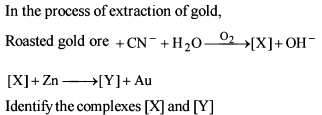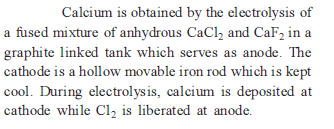JEE Exam > JEE Tests > Chemistry for JEE Main & Advanced > General Principles and Processes of Isolation of Metals - 1 - JEE MCQ
General Principles and Processes of Isolation of Metals - 1 - JEE MCQ
Test Description
12 Questions MCQ Test Chemistry for JEE Main & Advanced - General Principles and Processes of Isolation of Metals - 1
General Principles and Processes of Isolation of Metals - 1 for JEE 2025 is part of Chemistry for JEE Main & Advanced preparation. The General Principles and Processes of Isolation of Metals - 1 questions and answers have been
prepared according to the JEE exam syllabus.The General Principles and Processes of Isolation of Metals - 1 MCQs are made for JEE 2025 Exam. Find important
definitions, questions, notes, meanings, examples, exercises, MCQs and online tests for General Principles and Processes of Isolation of Metals - 1 below.
Solutions of General Principles and Processes of Isolation of Metals - 1 questions in English are available as part of our Chemistry for JEE Main & Advanced for JEE & General Principles and Processes of Isolation of Metals - 1 solutions in
Hindi for Chemistry for JEE Main & Advanced course. Download more important topics, notes, lectures and mock
test series for JEE Exam by signing up for free. Attempt General Principles and Processes of Isolation of Metals - 1 | 12 questions in 20 minutes | Mock test for JEE preparation | Free important questions MCQ to study Chemistry for JEE Main & Advanced for JEE Exam | Download free PDF with solutions
Detailed Solution for General Principles and Processes of Isolation of Metals - 1 - Question 1
General Principles and Processes of Isolation of Metals - 1 - Question 2
Main source of lead is PbS. It is converted to Pb by :


Self - reduction pocess is :


Detailed Solution for General Principles and Processes of Isolation of Metals - 1 - Question 2
General Principles and Processes of Isolation of Metals - 1 - Question 3
Among the following statements, the incorrect one is :
Detailed Solution for General Principles and Processes of Isolation of Metals - 1 - Question 3
General Principles and Processes of Isolation of Metals - 1 - Question 4
Which of the following statement is incorrect about the extractive metallurgy of copper ?
Detailed Solution for General Principles and Processes of Isolation of Metals - 1 - Question 4
Detailed Solution for General Principles and Processes of Isolation of Metals - 1 - Question 5
Detailed Solution for General Principles and Processes of Isolation of Metals - 1 - Question 6
Detailed Solution for General Principles and Processes of Isolation of Metals - 1 - Question 7
General Principles and Processes of Isolation of Metals - 1 - Question 8
Which of the following process is used in the extractive metallurgy of magnesium ?
Detailed Solution for General Principles and Processes of Isolation of Metals - 1 - Question 8
General Principles and Processes of Isolation of Metals - 1 - Question 9
NaCN is sometimes added in the froth flotation process as a depressant when ZnS and PbS minerals are expected because :
Detailed Solution for General Principles and Processes of Isolation of Metals - 1 - Question 9
General Principles and Processes of Isolation of Metals - 1 - Question 10
Match the column (I) and (II) and select the correct answer using the codes given below.

Detailed Solution for General Principles and Processes of Isolation of Metals - 1 - Question 10
Detailed Solution for General Principles and Processes of Isolation of Metals - 1 - Question 11
General Principles and Processes of Isolation of Metals - 1 - Question 12
The one that is not a carbonate ore is :
Detailed Solution for General Principles and Processes of Isolation of Metals - 1 - Question 12
|
361 videos|822 docs|301 tests
|
Information about General Principles and Processes of Isolation of Metals - 1 Page
In this test you can find the Exam questions for General Principles and Processes of Isolation of Metals - 1 solved & explained in the simplest way possible.
Besides giving Questions and answers for General Principles and Processes of Isolation of Metals - 1, EduRev gives you an ample number of Online tests for practice





























